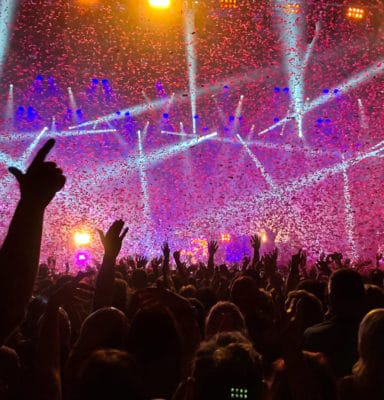With 2017 in the books, it seems only appropriate to look back in time to see which technologies had the greatest impact on meetings and trade shows. Although some of the tools listed below are not new, they did and will continue to make a difference in the event industry in the coming year.
Let’s take a stroll down memory lane.
2017 Technology that Made the Cut

Whether it was Virtual Reality (VR), Augmented Reality (AR) or Mixed Reality (MR), this technology really took off last year.
According to meeting planners I have spoken with, the combination of hardware and software offerings attracted younger
attendees to their events. The blend of immersion and gamification lent to a feeling of being there, and the excitement was contagious.
Look for more applications and hardware improvements to roll out this year.
Personal Live Streaming
First it was Periscope, now it is Facebook Live, Instagram Story and Snapchat Live. Also known as crowd streaming, this type of video production gave a layer of
authenticity because it was produced by attendees for a broader audience. It captured the essence of the event in real-time mode.
Social Walls
Often referred to as Video Walls, these contiguous monitors were used effectively to show social media feeds, gamification standings and live presentation streaming from the event.
Metric Measurements
Planners got on the bandwagon of looking at website,
social media and email metrics to determine where users landed and how effective different online marketing tools were. These analytics drove better use of the technology and provided an effective strategy towards paid campaigns to garner more awareness, conversations and conversions. As this landscape continues to change (i.e. focus on paid posts, search parameters, email best practices), meeting planners will have to keep abreast of these changes or pay an outside agency to do so for them.
Geofencing
The use of RFID, NFC and iBeacon technology provided an opportunity to send attendees highly contextual, meaningful messages and advertisements on their mobile devices when they were a few feet away from a trade show booth or event space. While the use of this technology started out strong in 2017, the hacking threats associated with these solutions continued.
If, and only if, stronger end-to-end encryption occurs this year, geofencing will not be widely accepted in 2018.
Facial Recognition

Late last year when the iPhone X and Samsung Galaxy S8 rolled out, facial recognition was a big part of these announcements.
Even though facial recognition applications are yet to be written for smartphones, event planners believe apps will be available in 2018 to measure the mood and body language of attendees.
More Inclusive Registration Systems
Rather than hosting registration and payment systems for an event, many planners used one application that allowed them to sell merchandise, book an accommodation and reserve parking for each attendee.
Look for more bells and whistles added to online registration applications this year.
DIY Events
The number of do-it-yourself meetings rose in 2017.
Expect this trend to increase. What is driving this boom? The number of easy-to-use applications such as Eventbrite, Facebook Events and MeetUp. All of these apps have e-commerce and social media integration within their systems to automate the registration process and help spread the word about the event.
Brought to You by SmartSource® Rentals
Want to learn more about our technology solutions for an upcoming trade show, user conference or corporate event? Contact us, and one of our experienced sales staff will contact you within one business day about your needs.

